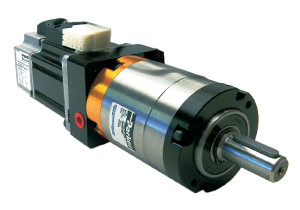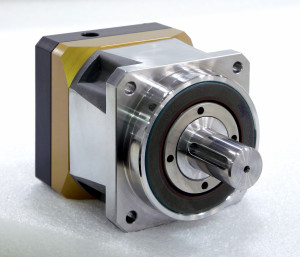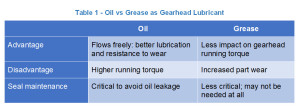 Originally Posted by Parker Electromechanical Team on Wed. August 31, 2016
Originally Posted by Parker Electromechanical Team on Wed. August 31, 2016
 Design engineers developing applications using servo motors and gearheads must lend consideration to thermal issues. Machine performance requirements have become significantly more demanding, making the effects of temperature change a primary concern to the designer. As both servo motors and gearheads are sources of heat, it is important to understand the effects of both excessive heat and temperature variation.
Design engineers developing applications using servo motors and gearheads must lend consideration to thermal issues. Machine performance requirements have become significantly more demanding, making the effects of temperature change a primary concern to the designer. As both servo motors and gearheads are sources of heat, it is important to understand the effects of both excessive heat and temperature variation.
As one might expect, when servo motors and gearheads are coupled together, there can be trouble determining which component is generating the heat–and what percentage of heat is dissipated vs transferred to the other components.
As technological advancements focus on heat reduction in the gearhead, one can no longer assume that the mechanical structure is the primary source of heat. Moreover, consideration must be given to application requirements, which may have a major impact on the temperature rise of the servo motor and the gearhead, particularly as amplifiers/controls handle peak current differently.
When considering the basic design criteria of a gearhead, several factors relate directly to heat generation:
- Tooth geometry
- Heat treatment/surface finish
- Lubrication
- Bearing selection
Tooth geometry
There are a number of considerations that surround a chosen tooth geometry and the effect that it may have on heat. First, is the basic issue of developing a profile that optimizes the rolling contact and minimizes the sliding friction. The amount of sliding that occurs between gear teeth will significantly impact the amount of heat that is generated. An involute tooth profile is the most common choice among gearhead manufacturers who are looking to optimize performance in this manner.
In addition, gear tooth tip relief, also called crowning, reduces the amount of impact that occurs as one gear tooth engages another. Optimizing the entry and exit points of the gears reduces vibration and noise and further reduces material that can cause sliding friction and heat generation.
 Heat treatment/surface finish
Heat treatment/surface finish
As all gears have teeth in contact, with some percentage of rolling and some percentage of sliding, it is important to understand the impact of heat treatment methods and the resulting surface finish. Similar to issues related to the tooth geometry, the heat that is generated from the sliding friction is directly related to the surface finish of the gears and the ability to maintain a well lubricated surface.
Common processes used to heat treat gears include carburizing and induction heating. As both of these processes involve very high temperatures and quenching, it is necessary to grind the gears after heat treating. The objective of the post-process grinding is to yield a surface finish that will reduce the coefficient of friction between the teeth. The primary short-coming of this process is that as industry strives to increase the surface finish, the ability to retain lubrication becomes more difficult as the pores of the metal are closed.
In contrast, the process of plasma nitriding provides the ability to achieve a hard surface without using excessive temperature to harden. It is a computer controlled process where the case depth of the tooth hardness can be precisely controlled. Surface hardness is typically kept at 63 Rc for excellent wear characteristics while the core is kept at 37 Rc for excellent shear strength characteristics (fig. 1). Basically, it allows the tooth to flex while under load vs. a brittle tooth that might break, all while maintaining a hard surface to minimize wear.

Plasma nitriding is done at a lower temperature than carburizing or induction heating. No material distortion occurs so there is no requirement for post process grinding. The result is a surface finish that supports the retention of lubrication and the smooth rotation of the meshing gears. The reduction of friction between the gear meshes also reduces the amount of heat that is generated during operation.
Lubrication
Lubrication is key to gearhead performance. It reduces the amount of friction that occurs between the mating components found within a gearhead, which reduces the amount of wear that occurs over time. It also reduces the amount of heat that is generated during operation.
Synthetic lubricants are typically chosen based on their energy efficiency benefits. They provide a thicker lubricant film at operating temperature versus mineral oils, which reduces the extent of metal to metal contact and the associated energy loss caused by friction. Other benefits of synthetic lubricants include:
- Better low and high temperature viscosity performance
- Decreased evaporation loss
- Resistance to oxidation, thermal breakdown, and sludge problems
Oil or grease may also be chosen to lubricate a gearhead. Some of the pros and cons are shown in Table 1.

The choice of lubricant will depend upon your other design performance requirements and constraints.
Bearing selection
The choice of bearings in the design of a gearhead will determine the amount of radial load, axial thrust, and moment loads that can be applied to the output shaft of the gearhead. It will also determine how smoothly the gears rotate within the gearhead and will determine how much torque can be generated through the gear train given the side loads that they will need to support.
 Different bearings can be chosen by a gearhead manufacturer. Deep groove ball bearings are popular, as well as angular contact and tapered roller bearings. The choice typically depends on what the manufacturer is looking to accomplish.
Different bearings can be chosen by a gearhead manufacturer. Deep groove ball bearings are popular, as well as angular contact and tapered roller bearings. The choice typically depends on what the manufacturer is looking to accomplish.
Tapered roller bearings, for example, provide excellent load carrying capabilities as they are cylinder shaped and the weight they support is distributed via a line contact. This same line contact results in a larger surface area that generates additional friction and heat.
A deep groove ball bearing supports its load via a point contact. It cannot carry the same amount of weight as the tapered roller bearing, but it can also operate at higher speeds while not generating as much heat.
Learn more
Gearhead choice is typically driven by what the product is designed to achieve relative to performance and price. For example, our PV gearheads use tapered roller bearings and grease in the design while the PS gearheads use angular contact bearings and oil in the design.
Learn more about planetary gearheads in this presentation video:
You can use our catalog to define the product performance parameters that best suit your design choices and requirements—or contact us for more answers to your gearhead questions.
Article contributed by Jeff Nazzaro, product manager for gearheads and motors, Electromechanical and Drives Division, Parker Hannifin Corporation.
